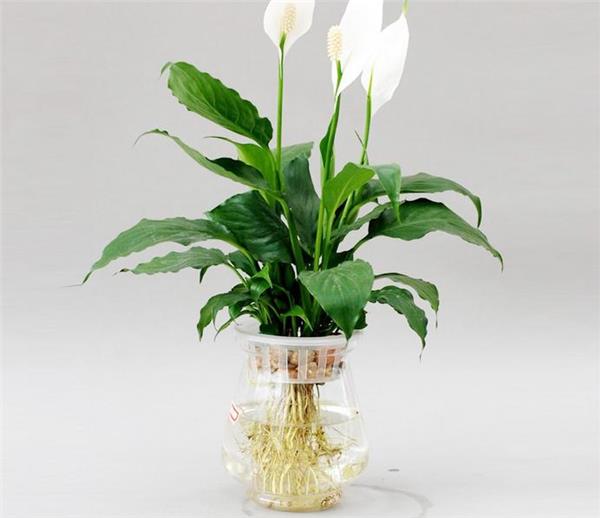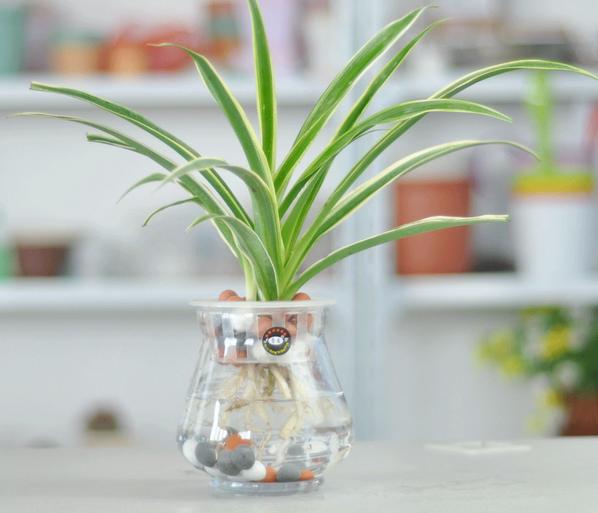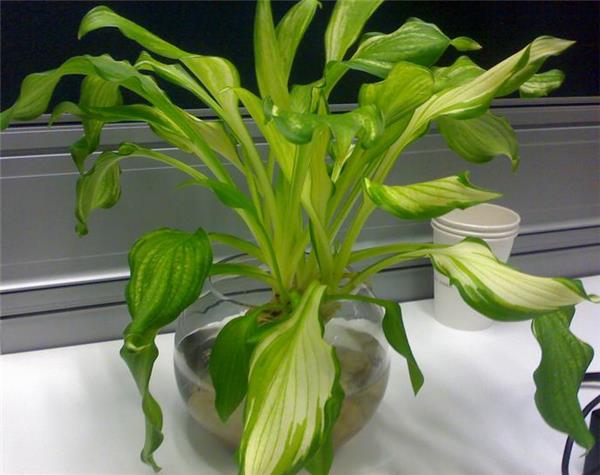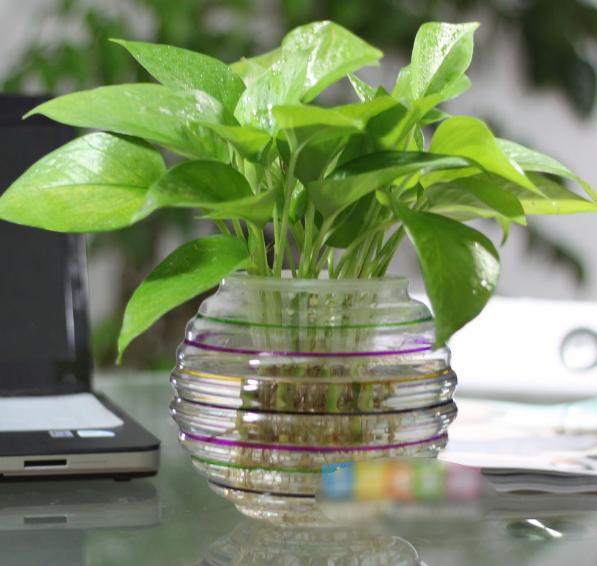How to cultivate hydroponic plants well
Everyone hopes that their home has fresh air and full of vitality, hydroponic plants in the home is a good choice, its green is always full of infinite vitality, bringing fresh and natural air indoors, how to raise hydroponic plants, the following will open a new plant planting method for you.

How to cultivate hydroponic plants well
First, we should know that the flowers we plant use pots, bottles, vats and other utensils without bottom holes to apply liquid fertilizer {nutrient solution} in the way of hydroponics, so their fertilization techniques are different from other cultivation. Because the substrate of soil cultivation is soil, and the surface of soil particles can absorb some nutrients, and the excess nutrients can be lost automatically through the leak at the bottom of the basin, so it plays a certain role in buffering the concentration of fertilization. But the fertilization of hydroponic flowers is different. all kinds of nutrient elements in the nutrient solution we apply are all dissolved in water, as long as they slightly exceed the tolerance of flowers to fertilizer concentration, it will cause harm. Due to the above characteristics, it is very important to strictly control the amount and types of fertilizer applied to hydroponic flowers. Therefore, in the application of nutrient solution, attention should be paid to the selection of special fertilizer for hydroponic flowers. And use in strict accordance with the instructions, strictly prevent the application of too much, excessive concentration caused by fertilizer damage.
Second, in terms of the amount and time of fertilization, we should mainly master the principle of applying less fertilizer frequently and preferring less than more, and according to the number of times of changing water, we should generally add nutrient fertilizer every time we change water. To replenish the fertilizer loss caused by the change of water.

Third, hydroponic flowers should be fertilized scientifically and reasonably according to their different conditions.
[1] rational fertilization. As we all know, the medium of hydroponic flowers is water, and the fertilizer used is completely mineral inorganic nutrition, and it is made of a variety of nutrient elements {a large number of elements and trace elements}. For the nutrients contained in water, we are also relatively clear; flowers need a large number of elements nitrogen, phosphorus, potassium is almost blank, the trace elements compared with the soil, is also very different. It is far from being able to meet the normal needs of flowers, so it is said that the timely and reasonable fertilization of hydroponic flowers. It is undoubtedly a very important management measure. So how to master the characteristics, quantity, time and technology of fertilization for hydroponic flowers?
Reasonable fertilization according to different flower species: this is because different flower species have different adaptability to fertilizer. The general rule is that flowers with slender roots, such as coloured leaf grass, begonia and other flowers have poor fertilizer tolerance and do not need a large amount of fertilizer and higher concentration. Therefore, the principle of light, little and sparse should be grasped when fertilizing. On the other hand, many flowers, such as grain taro, ruby and Xilin taro, are more fertilizer-resistant. The principle of less application and diligent fertilization can be mastered. In addition, the foliage flowers should be fertilized mainly by nitrogen fertilizer, supplemented by phosphorus and potassium fertilizer, in order to ensure that the leaves are thick, smooth and pure. However, we must pay attention to the flower species with color stripes or patches on their leaves, and apply less nitrogen fertilizer appropriately, because when there is too much nitrogen fertilizer, the foliar color will fade, or even disappear, and appropriate application of phosphorus and potassium fertilizer should be applied. For flowering flowers, they must be in the stage of flower bud differentiation and flower bud development, dominated by phosphorus and potassium fertilizer, supplemented by nitrogen fertilizer appropriately, so as not to cause overgrowth of plants and affect reproductive growth, resulting in small flowers, few flowers, light flower color, and even the adverse consequences of not blooming.

Reasonable fertilization according to season and temperature: generally, when the summer temperature is high, the adaptability of flowers to fertilizer concentration decreases, so the concentration of fertilizer should be reduced at this time, especially for some flowers that are afraid of hot and hot heat, they both enter a dormant state in the high temperature season. the physiological activity of flowers is slow, and their growth is also in a state of semi-stop and stop. For this kind of flowers, fertilizer should be stopped at this time to avoid causing fertilizer damage.
Fertilize according to the growth potential of flowers: as we all know, our indoor lighting conditions are relatively poor. Although most of the foliage flowers cultivated indoors prefer shade or semi-shade environment, the growth of their plants will be relatively weak in the case of lack of light or too weak light for a long time, so their adaptability to fertilizer concentration will also be reduced. for poor growth in poor light conditions or plants caused by other reasons, fertilization should be stopped or less, and the concentration of fertilization should be reduced as far as possible.
Several problems that should be paid attention to when fertilizing: first, freshly hydroponically cultivated flowers, which have not yet adapted to the environment in the water, often appear that the leaves turn yellow or individual rotten roots are present, so don't rush to apply fertilizer at this time, but stop for about ten days. Fertilize after adapting to the environment or taking new aquatic roots. Second, do not apply urea directly into the water, because urea is a kind of artificial inorganic synthetic organic fertilizer, and hydroponics is cultivated in the state of asepsis or few bacteria. if urea is applied directly, not only flowers can not absorb nutrients, but also some harmful bacteria or microorganisms will multiply quickly and cause water pollution, and cause ammonia damage to flowers and cause flower poisoning. Third, if it is found that excessive fertilization causes the root system of flowers to rot, and causes water quality to deteriorate and pollute and stink, the rotten roots should be cut off quickly, and water should be changed and washed in time.

[2] change the water to wash the roots. The management technology of hydroponic flowers changing water and washing roots is an important link to ensure the good growth of hydroponic flowers. So why do you want to change the water to wash the roots of hydroponic flowers?
First, the conditions for plant growth are mainly water, nutrients and air, the water and nutrients of hydroponic flowers can absolutely guarantee their needs, and the oxygen content of oxygen in water will gradually decrease with the growth of flowers, when reduced to a certain extent, it will affect the growth of flowers due to hypoxia, although the oxygen in the air will continue to supplement to the water, but the amount of oxygen is far from enough.
Second, hydroponic flowers often apply nutritional fertilizer to the water, except for some mineral elements absorbed by the root system, the rest remain in the water, when the residual material reaches a certain amount, it will also do some harm to the flowers. Fourth, the roots of hydroponic flowers growing in water for a long time will produce a kind of mucus, which will not only affect the absorption of nutrients by flower roots, but also pollute the water. Due to the above reasons, hydroponic flowers must be managed by regular water change and root washing. So, how do we master the technology and time of root washing by changing water? One is to change water regularly according to different kinds of flowers and their adaptation to hydroponic conditions. Some flowers, especially aquatic or wet flowers, are well adapted to the hydroponic environment. After hydroponic cultivation, they can continue to grow new roots on the original roots and grow well. For these flowers, the interval between changing water can be longer. However, some flowers do not adapt to the hydroponic environment after hydroponic cultivation, and their recovery and growth is slow, and even root rot occurs after hydroponic cultivation. For these flowers, in the early stage of entering the hydroponic environment, the water should be changed frequently, or even once a day or two. The times of changing water can not be gradually reduced until the new roots germinate and return to normal growth. Second, there is a close relationship between the temperature and the growth of plants. The higher the temperature, the less the oxygen content in the water; the lower the temperature, the higher the oxygen content in the water. On the other hand, the higher the temperature, the stronger the respiration of plants and the more oxygen they consume; the lower the temperature, the weaker the respiration of plants and the less oxygen they consume. Therefore, the oxygen content decreases when the temperature is high, and there is more oxygen in the water when the temperature is low. Therefore, the water should be changed frequently in the high temperature season, and the interval of water change in the low temperature season is longer. The third is to master that the flowers grow normally and the plants are strong, and the time of changing water is longer, while those that cause poor growth of flowers and plants due to various reasons, change water frequently. According to the above aspects, for the requirements of changing water and washing roots, we can roughly grasp the following principles; in hot summer, change water every 4-5 days, and in spring and autumn, you can change water about once a week. The time of changing water in winter should be longer, generally changing water once every 15-20 days. When changing water, wash away the mucus from the root very carefully, and remember not to break or damage the root system. If you find utensils, rocks and other moss, you should remove them in time. In order to improve the ornamental value and facilitate the normal growth of flowers.
[3] spray water to wash leaves. Hydroponic flowers, especially indoor hydroponic foliage plants, most of them like higher air humidity, if the indoor air is too dry, it will cause the focal tip or edge of the leaves. Thus affecting the ornamental value of flowers. Therefore, usually should often spray water on the plant, so as to improve the humidity of the air, which is conducive to the normal growth of flowers.
Hydroponic plant is a new way of soilless cultivation of plants. Hydroponic plants like hydroponic green pineapple, which only existed in laboratories or enterprises, have gradually entered thousands of households. This paper introduces how to raise hydroponic plants and hydroponic cultivation methods of hydroponic green pineapple, and gives some negligible suggestions for people who dare to try or like their own DIY hydroponic green pineapple.
Do not rush to fertilize at this time, you can stop for about ten days, and apply fertilizer after adapting to the environment or taking new water roots. Second, do not apply urea directly into the water, because urea is a kind of artificial inorganic synthetic organic fertilizer, and hydroponics is cultivated in the state of asepsis or few bacteria. if urea is applied directly, not only flowers can not absorb nutrients, but also some harmful bacteria or microorganisms will multiply quickly and cause water pollution, and cause ammonia damage to flowers and cause flower poisoning. Third, if it is found that excessive fertilization causes the root system of flowers to rot, and causes water quality to deteriorate and pollute and stink, the rotten roots should be cut off quickly, and water should be changed and washed in time.

[2] change the water to wash the roots. The management technology of hydroponic flowers changing water and washing roots is an important link to ensure the good growth of hydroponic flowers. So why do you want to change the water to wash the roots of hydroponic flowers?
First, the conditions for plant growth are mainly water, nutrients and air, the water and nutrients of hydroponic flowers can absolutely guarantee their needs, and the oxygen content of oxygen in water will gradually decrease with the growth of flowers, when reduced to a certain extent, it will affect the growth of flowers due to hypoxia, although the oxygen in the air will continue to supplement to the water, but the amount of oxygen is far from enough.
Second, hydroponic flowers often apply nutritional fertilizer to the water, except for some mineral elements absorbed by the root system, the rest remain in the water, when the residual material reaches a certain amount, it will also do some harm to the flowers. Fourth, the roots of hydroponic flowers growing in water for a long time will produce a kind of mucus, which will not only affect the absorption of nutrients by flower roots, but also pollute the water. Due to the above reasons, hydroponic flowers must be managed by regular water change and root washing. So, how do we master the technology and time of root washing by changing water? One is to change water regularly according to different kinds of flowers and their adaptation to hydroponic conditions. Some flowers, especially aquatic or wet flowers, are well adapted to the hydroponic environment. After hydroponic cultivation, they can continue to grow new roots on the original roots and grow well. For these flowers, the interval between changing water can be longer. However, some flowers do not adapt to the hydroponic environment after hydroponic cultivation, and their recovery and growth is slow, and even root rot occurs after hydroponic cultivation. For these flowers, in the early stage of entering the hydroponic environment, the water should be changed frequently, or even once a day or two. The times of changing water can not be gradually reduced until the new roots germinate and return to normal growth. Second, there is a close relationship between the temperature and the growth of plants. The higher the temperature, the less the oxygen content in the water; the lower the temperature, the higher the oxygen content in the water. On the other hand, the higher the temperature, the stronger the respiration of plants and the more oxygen they consume; the lower the temperature, the weaker the respiration of plants and the less oxygen they consume. Therefore, the oxygen content decreases when the temperature is high, and there is more oxygen in the water when the temperature is low. Therefore, the water should be changed frequently in the high temperature season, and the interval of water change in the low temperature season is longer. The third is to master that the flowers grow normally and the plants are strong, and the time of changing water is longer, while those that cause poor growth of flowers and plants due to various reasons, change water frequently. According to the above aspects, for the requirements of changing water and washing roots, we can roughly grasp the following principles; in hot summer, change water every 4-5 days, and in spring and autumn, you can change water about once a week. The time of changing water in winter should be longer, generally changing water once every 15-20 days. When changing water, wash away the mucus from the root very carefully, and remember not to break or damage the root system. If you find utensils, rocks and other moss, you should remove them in time. In order to improve the ornamental value and facilitate the normal growth of flowers.
[3] spray water to wash leaves. Hydroponic flowers, especially indoor hydroponic foliage plants, most of them like higher air humidity, if the indoor air is too dry, it will cause the focal tip or edge of the leaves. Thus affecting the ornamental value of flowers. Therefore, usually should often spray water on the plant, so as to improve the humidity of the air, which is conducive to the normal growth of flowers.
Hydroponic plant is a new way of soilless cultivation of plants. Hydroponic plants like hydroponic green pineapple, which only existed in laboratories or enterprises, have gradually entered thousands of households. This paper introduces how to raise hydroponic plants and hydroponic cultivation methods of hydroponic green pineapple, and gives some negligible suggestions for people who dare to try or like their own DIY hydroponic green pineapple.
Related
- Wuhan Hospital Iron Tree Blooming Result Was Instantly Frightened by the Gardener Master
- Which variety of camellia is the most fragrant and best? Which one do you like best?
- What is the small blue coat, the breeding methods and matters needing attention of the succulent plant
- Dormancy time and maintenance management of succulent plants during dormancy
- Minas succulent how to raise, Minas succulent plant pictures
- What are the varieties of winter succulent plants
- How to raise succulent plants in twelve rolls? let's take a look at some experience of breeding twelve rolls.
- Attention should be paid to water control for succulent plants during dormant period (winter and summer)
- Watering experience of twelve rolls of succulent plants
- Techniques for fertilizing succulent plants. An article will let you know how to fertilize succulent plants.



